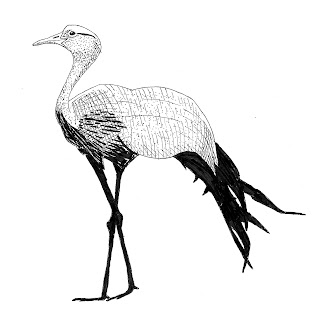 |
| Blue Crane (National Bird of South Africa) |
Compared to equatorial Africa (e.g. Kenya, Uganda), southern Africa has fewer recorded species, but the bird list still stands at a robust 858 species. It isn't all about the numbers though. Another interesting measure of diversity is the number of endemic and near-endemic birds in a country or region.
The number of true endemics within the political boundaries of the country of South Africa is only 29 species. That might seem small when you consider that Jamaica, a country with a much smaller land area, has a comparable 28 endemics. However it is important to bear in mind that island biogeography skews the endemism rate. It is also important to consider that not all species are created equally; island endemic forms often bare close resemblance (and evolutionary propinquity) to avian forms from the closest mainland or other islands neighbours. The endemism in southern Africa is more striking than this.
But pure endemism is too high a standard; after all, birds have wings and are no respecters of political boundaries! When we take this perspective, we see that it is on a regional level where the endemic rates of southern Africa really soar: approximately 100 endemics, plus 6 breeding endemics and an additional 68 near-endemics.
Almost every bird we see on our trip will be a lifer, so I am not overly focused on getting the endemic species, but it will be a consideration. Some "hoped for" species include Blue Crane, Southern Bald Ibis, Cape Rockjumper and Cape White-eye. Just as desirable are representatives of the African endemic families: Ostrich, Guineafowl, Hammerkop, Turacos, Mousebirds, Wood Hoopoes, Ground Hornbills, Wattle-eyes and Batises, Helmet-Shrikes and Puffbacks, Indigobirds and (especially, since they are the most range-restricted) Sugarbirds.











